
Self-esteem Levels in a Representative Sample of Spanish Adolescents: Analysis and Standardization
[Los niveles de autoestima en una muestra representativa de adolescentes españoles: análisis y estandarización]
Eva Solera1, Sonia Gutiérrez-Gómez-Calcerrada1, and Juan Calmaestra2
1Universidad Internacional de La Rioja, Spain; 2Universidad de CĂłrdoba, Spain
https://doi.org/10.5093/psed2024a3
Received 15 February 2023, Accepted 31 October 2023
Abstract
The objective of the present study was the standardization of the Rosenberg Self-Esteem Scale (RSES; Rosenberg, 1989), adapted and validated by Martín-Albo et al. (2007) in the Spanish population at the secondary education stage. The sample consisted of 25,706 students, selected randomly. The analysis of the data obtained indicated an adequate factorial structure of the instrument and its invariance by sex. For a better adaptation of the scale, a division of the test was carried out according to the self-deprecation and self-confidence variables. The scales indicated an increase in self-confidence across both sexes with increasing age, but the girls’ scores were lower than the boys’ at all ages. The present research provides a self-esteem scale for Spanish adolescents through an assessment instrument that is easily applicable and accessible for the educational community.
Resumen
El objetivo de la presente investigación ha sido la estandarización de la Rosenberg Self-Esteem Scale (RSES; Rosenberg, 1989), adaptada y validada por Martín-Albo et al. (2007) en la población española de la etapa de educación secundaria. La muestra constaba de 25,706 alumnos, elegidos aleatoriamente. El análisis de los datos obtenidos indica que tiene una adecuada estructura factorial e invarianza por sexo. Para una mejor adecuación de la baremación se realizó una división de la prueba en las variables autodesprecio y autoconfianza. Los baremos indican que la autoconfianza en ambos géneros mejora a medida que aumenta la edad, siendo las puntuaciones de las chicas menores que las de los chicos en todas las edades. La investigación aporta una escala de autoestima para los adolescentes españoles mediante un instrumento de evaluación fácilmente aplicable y accesible para la comunidad educativa.
Palabras clave
Autoestima, Adolescentes, EstandarizaciĂłn, InvarianzaKeywords
Self-esteem, Adolescents, Standardization, InvarianceCite this article as: Solera, E., Gutiérrez-Gómez-Calcerrada, S., & Calmaestra, J. (2024). Self-esteem Levels in a Representative Sample of Spanish Adolescents: Analysis and Standardization. PsicologĂa Educativa, 30(1), 39 - 45. https://doi.org/10.5093/psed2024a3
Correspondencia: sonia.gutierrez@unir.net (S. Gutiérrez Gómez-Calcerrada).
Different definitions have been proposed for self-esteem, although most tend to consider it as the subjective assessment of oneself (Bleidorn et al., 2016; Brailovskaia & Margraf, 2020; Chung et al., 2017; Grover, 2021). Concerning this approach, some researchers, such as Pope et al. (1996), have associated it with the ideal concept of oneself, which was already proposed by James in 1890 (cited by Dentale et al., 2018), suggesting that self-esteem is the relationship between how one sees oneself and how one would like to be. Other researchers related it to our ability to self-evaluate (Acosta, 1998; Musitu & Román, 1983). Rosenberg (1973), in turn, considered that it is the positive or negative assessment of oneself, suggesting a continuum from a high level to a low level, depending on whether this self-assessment is positive or negative. This evaluation of oneself has its origin in early developmental stages, when a child is able to see that he/she is different from his/her environment, from the people and objects that are around him/her, and thus, he/she develops a body image of him/herself. This process takes place between the ages of one and a half years and two years; and from that moment on, he/she elaborates his/her own identity, considering his/her own characteristics and the difference with others, the relationship with them, the language, his/her belongings, etc. It is a stage when the child seeks the recognition and acceptance and praise of others in carrying out the activities that are most satisfactory to him/her, with these behaviors being the ones that allow us to identify his/her self-esteem (Lucas-Molina et al. 2022; Mateos, 2001). The term self-concept is closely related to self-esteem. Self-concept can be said to be the way one perceives oneself through the information obtained from one’s own different experiences and from those provided by the immediate environment (González-Pienda et al., 1997). Galindo-Domínguez (2019) indicated various authors have considered self-concept in a unidimensional and global way, although self-concept is currently understood as hierarchical and multidimensional (Cazalla-Luna & Melero, 2013; Gorges & Hollman, 2019; Rodríguez-Naranjo & Caño-González, 2012). As Markus and Kitayama (1991) pointed out, it is an emotionally important aspect that motivates and drives our behavior. Purkey (1970) considered that self-concept is based on the perception that the person has of him/herself. Subsequently, it has been argued that this perception is influenced by information and the influence of other people, which determines the assessment we make of the image we have of ourselves (Shavelson et al., 1976). In other words, it influences our self-esteem, related to the ideal self-concept, which would be related, on the one hand, to the ideal that we set for ourselves and, on the other, to the one that others set about us (González-Pienda et al., 1997). In fact, various studies insisted on the protective influence that different environments (school, family, community, etc.) can have on their development, as the studies carried out by Días & Cadime (2017) in Portugal and by Ruvalcaba et al. (2017) in México. Other international and national studies have also pointed out that the way adolescents perceive themselves undergoes changes with age and is based on sex or social and economic level (Bleidorn et al., 2016; Portillo & Fernández-Baena, 2020; Tabernero et al., 2017). Along these lines, as these researchers pointed out, the final self-concept is the result of the relationship between self-image and self-esteem. Therefore, both can be positive or negative, depending on the assessment of each person, which considers different aspects: physical, emotional, personality, social, academic, work, family, etc. (Rodríguez-Naranjo & Caño-González, 2012). Between the ages of five and twelve, relationships and social experiences have an important influence on children’s behavior and on how they define themselves, which is also influenced by how others see them. In fact, comparison with others has a huge influence on their self-concept and self-esteem (Lucas-Molina et al. 2022; Mateos, 2001). Researchers have established three stages during adolescence: early, middle, and late adolescence (Havighurst, 1972; Steinberg, 2002). Certain studies (Parra et al., 2004) indicated that the first stage is where more physical, social, and educational changes tend to take place, which may be associated with lower self-esteem. But in later stages, after reaching a certain stability and even improvements, self-esteem tends to increase (Bleidorn et al., 2016; Parra et al., 2004), and even more so at the beginning of adulthood (González-Pienda et al., 1997). However, some studies have considered that the development of self-esteem is related to individual characteristics, because there are people who do not experience changes throughout adolescence (Parra et al., 2004). Regarding the existence or not of gender differences, researchers obtained all kinds of results. Some authors contend that there are no differences, while other authors conclude that it is the girls who present higher self-esteem and others that it is the boys (as seen in Gómez-Lugo et al.’s, 2016 study). However, it has also been pointed out that the differences between them depend mainly on their age. In particular, in Cardenal and Díaz’s (2000) Spanish study, boys obtained higher scores in global self-esteem, mainly in the intellectual and school areas, whereas girls obtained worse scores in the physical area and higher scores in the area of social anxiety. In this regard, Parra et al. (2004) highlighted the importance of physique in the initial stage of adolescence, mainly in girls, which would explain these results. Nevertheless, the research carried out by the Bleidorn et al.’s (2016) group, collecting data on the self-esteem of the population aged between 16 and 45 years across 48 countries, also indicates that men present higher levels of self-esteem than women and that in both cases there is an increase in self-esteem with age, highlighting the last phase of adolescence and the beginning of adulthood. The authors related both gender differences and the development with age with biological, cultural, socioeconomic, and sociodemographic factors. The results of the Spanish study by Ramos-Díaz et al. (2017) seem to agree with the previous study, indicating that 12-to-15-year-old boys present a better self-concept than girls, which these authors related to greater subjective well-being and satisfaction with life, observing a decrease in all these aspects in the transition from first to second year of ESO (Compulsory Secondary Education). Kling et al.’s meta-analysis (1999) associated these data with social stereotypes related to confidence in boys and physique in girls. These researchers also added that this can be kept by the actions of teachers and/or parents. Likewise, we should not forget, as Parra et al. (2004) indicated, the important influence of peer relationships in these stages. The longitudinal study carried out by Chung et al. (2017) analyzed the development of the 9-to-20-year-old participants, indicating that there is a drop in self-esteem around the age of 12, but it begins to increase around the age of 13-14 years and continues to do so for the rest of adolescence and adulthood. Bearing this in mind, it is not surprising that self-concept and self-esteem evolve and change during the process of life development. However, self-esteem has been considered as the “global component of self-concept” (Marsh & Craven, 2006), but an unstable component, as it is influenced by the environment and by the other components of self-concept. Nevertheless, the component referring to personality characteristics provides some stability (Dentale et al., 2018). Usually, self-concept maintains stability, although its development is influenced by aspects such as close relationships, comparisons with other people, or the analyses we make of our behavior, and our emotional state. This is the reason why in the childhood the main influences are those coming from parents, teachers, and classmates, the comparison with the latter being frequent. Moreover, in secondary education, peers increase their influence, but there are many other influences that must be taken into account (González-Pienda et al., 1997). Among the different self-esteem assessment instruments, the most widely used and validated worldwide is the Rosenberg Self-Esteem Scale (RSES; Rosenberg, 1989). It is a one-dimensional self-assessment scale, although some researchers have assessed its possible two-dimensional structure, differentiating between positive and negative self-esteem (Chacón-Borrego, et al., 2022; Marsh et al., 2010; Michaelides et al., 2016). The ease of using this scale have encouraged its translation and adaptation to different languages (French, Persian, Chinese, Italian, Estonian, German, and Portuguese), as well as its validation in Spain, Chile, Argentina, and Colombia (Gómez-Lugo et al., 2016). In addition, several studies (Frieiro et al., 2021; Sánchez-Villena, et al., 2021) have pointed out that the Rosenberg’s (1989) Self-esteem Scale is a good instrument to assess self-esteem in adolescents. Thus, based on the importance of using a common assessment instrument for school professionals, as noted by Rojas-Barahona et al. (2009), and since there is no standardization of the main instrument to assess self-esteem in adolescence in the Spanish population, we set the objective of standardizing the Rosenberg Self-Esteem Scale (RSES; Rosenberg, 1989) in the Spanish population. Specifically, we focused our study on the standardization of the scale adapted and validated by Martín-Albo et al. (2007). This scale also acknowledges the close relationship between self-esteem and self-concept (Rodríguez-Naranjo & Caño-González (2012). In the present study, we provide information on age and sex differences in secondary education according to this scale, which until now had not been standardized in the Spanish population. Sample The sample consisted of 25,935 students in the Compulsory Secondary Education (ESO) stage from all over Spain, coming from public educational centers in different academic years (ESO 1st year = 6,627, ESO 2nd year = 6,906, ESO 3rd year = 6,231, ESO 4th year = 6,171). Students’ age ranged from 11 to 18 years (11 years = 112, 12 years = 4,499, 13 years = 5,933, 14 years = 6,054, 15 years = 5,958, 16 years = 2,356, 17 years = 906, 18 years = 117), although students aged 11 and 18 were subsequently removed from the study because they were a very small number of participants. Finally, 25,706 students made up the final sample, with a mean age of 13.94 years (SD = 1.39), where 48.1% of the participants were boys and 51.9% were girls (see Table 1 for the distribution by autonomous communities). The Large Universes formula (Rodríguez-Osuna, 1991) was used to calculate sampling error (see Table 2). The data was collected prior to the COVID-19 pandemic. Instrument The instrument used in this study was the adaptation and validation carried out by Martín-Albo et al. (2007) of the Rosenberg Self-Esteem Scale (RSES; Rosenberg, 1989). It is a scale composed of 10 items (5 positively formulated and another 5 negatively) with a 4-point Likert-type response pattern, where 1 is totally disagree and 4 is totally agree. The RSES is an instrument that evaluates a single dimension, general self-esteem, although some researchers (Supple et al., 2012; Tafarodi & Milne, 2002; Tafarodi & Swann, 2001; Viejo, 2012) proposed differentiating two dimensions: self-confidence and self-deprecation. According to them, self-confidence is related to a person’s positive assessment of him/herself and self-deprecation with a negative assessment. Therefore, in the present study, we will maintain such a differentiation. Along these lines, it was observed that the reliability data for self-confidence was high (α = .809 in our study) (depending on the items formulated in positive; items 1, 3, 4, 7, 10) and the same occurred with those of Self-deprecation (α = .805 in our study) (depending on the items formulated in negative; items 2, 5, 6, 8, 9). An example of a self-confidence item is “In general, I am satisfied with myself”, and an example of a self-deprecation item is “Ultimately, I tend to think that I am a failure”. Procedure Random cluster sampling was established using educational centers as selection units. The lists of all public schools were obtained from the official websites of the different autonomous communities. For each autonomous community, 10 regular centers and 10 substitute centers were selected randomly. Subsequently, the management of the participating centers were contacted to provide them with information about the study, including documentation related to the data collection process, as well as other aspects to be taken into account. If a starting center did not want to participate, the substitutes were contacted in order of appearance in the draw. A participation of at least 500 subjects per autonomous community was sought, values that were achieved in almost all autonomous communities. Those centers that voluntarily decided to take part in the study selected and established randomly the groups of students who completed the questionnaires and whose families provided the necessary informed consent for them to take part. For their part, the research staff provided each of the participating centers with a code that the students used to fill out the questionnaires online, as well as a protocol with all the indications and explanations that the teachers might need while the completion of the data by the students was being carried out. The present study was approved by the Ethics Committee of the University of Córdoba. Data Analyses Initially, in order to test the structure of the test, a confirmatory factor analysis was carried out. The indices used were the following: Satorra-Bentler’s χ2, comparative fit index (CFI), non-normalized fit index (NNFI), root mean square error of approximation (RMSEA) with 90% confidence interval, standardized root mean square residual (SRMR), and Akaike information criterion (AIC). As indicated by Hu and Bentler (1999), values greater than .95 in the CFI and NNFI indices demonstrate a good fit to the model. Values less than .08 are appropriate for the SRMR measure. Regarding the RMSEA index, there is a good adjustment when the values are less than .05, while the adjustment is reasonable when the values oscillate between .05 and .08 (Browne & Cudeck, 1993). In the present study, the ML estimation method was used with robust correction since the data were not normal; also, polychoric matrices were used to carry out the calculations. Next, in order to test the degree of invariance by sex of the participants, the delta (Δ) differences among the adjustment indicators (NNFI, CFI, and SRMR) were considered. According to Dimitrov (2010), the literature suggests a change of .01 as a cut-off point to accept the hypothesis of invariance between groups. Finally, descriptive analyses were carried out using percentiles and standardized scores to establish the corresponding scales, considering the sex and age variables. Although the variables in our study did not have a normal distribution, due to the large sample used and the random sample selection, we were able to base them on the Central Limit Theorem (Barron, 1986; Hoeffding & Robbins, 1948; Kwak & Kim, 2017; Rosenblatt, 1956). This theory states that the sum (or mean) of a large number of independent and identically distributed random variables tends to follow a normal distribution, regardless of the original distribution of the random variables. The fact that the distributions of these sums or means tend to be normal allows the normal distribution to be used for statistical testing and estimation, even when the underlying population is not normally distributed. In fact, it is relatively common to standardize non-normal variables such as depression (Kocalevent et al., 2013; Löwe et al, 2010) or anxiety (Löwe et al, 2008; Löwe et al, 2010) among other psychological variables. To carry out the statistical analysis of the data collected in the study, the EQS program and the statistical package SPSS version 25.0 were used. Factor Structure of the Instrument A confirmatory factorial analysis was carried out, which confirmed the factorial structure proposed by Martín-Albo et al. (2007). For this, the ML model was used, as the principles of normality and kurtosis were maintained. The data showed an optimal fit of the model (χ2 = 3133.566, p = .00, CFI = .96, NNFI = .95, RMSEA = .0064, SRMR = .04). Invariance by Sex To determine the existence of invariance by sex of the instrument, the corresponding analyses were carried out, the results of which are shown in Table 3. As we can see, the data shows the invariance between sexes. Standardization of the Test by Age and Sex A descriptive analysis of the test was carried out, dividing between the variables self-depreciation and self-confidence, establishing 5 cut-off points in the sample, to obtain 15 percentiles. In this study, the adaptation made by Martín-Albo et al. (2007) of the Rosenberg Self-Esteem Scale (RSES; Rosenberg, 1989) was taken as a reference point. According to these researchers, the value of self-confidence, between 5 and 20 points, is obtained by adding the values of items 1, 3, 4, 7, and 10. Thus, high values in this subscale indicate high levels of self-confidence. In the same way, the value of self-depreciation, also between 5 and 20, is obtained by adding items 2, 5, 6, 8, and 9. Likewise, high values in this subscale indicate high levels of self-depreciation. Table 4 Non-standardized Scores for the Self-confidence Variable  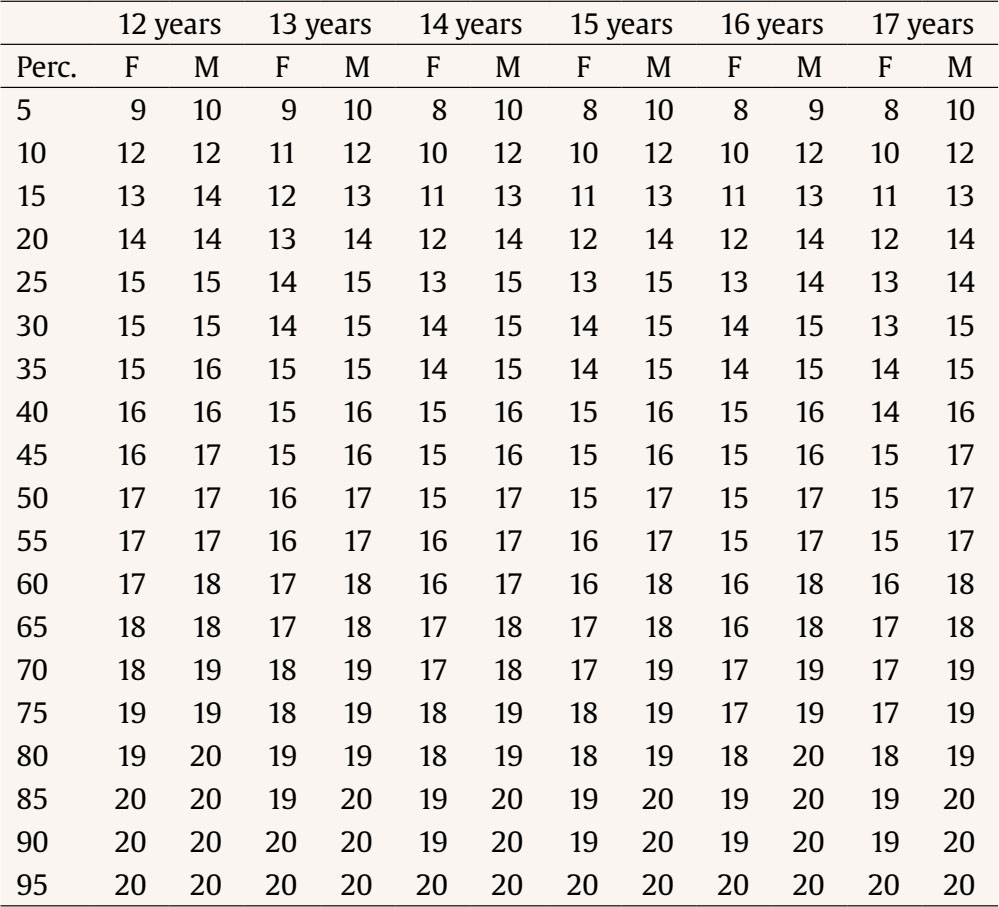 Note. Perc.= percentile; F = female; M = male. Table 5 Non-standardized Scores for the Variable Self-deprecation  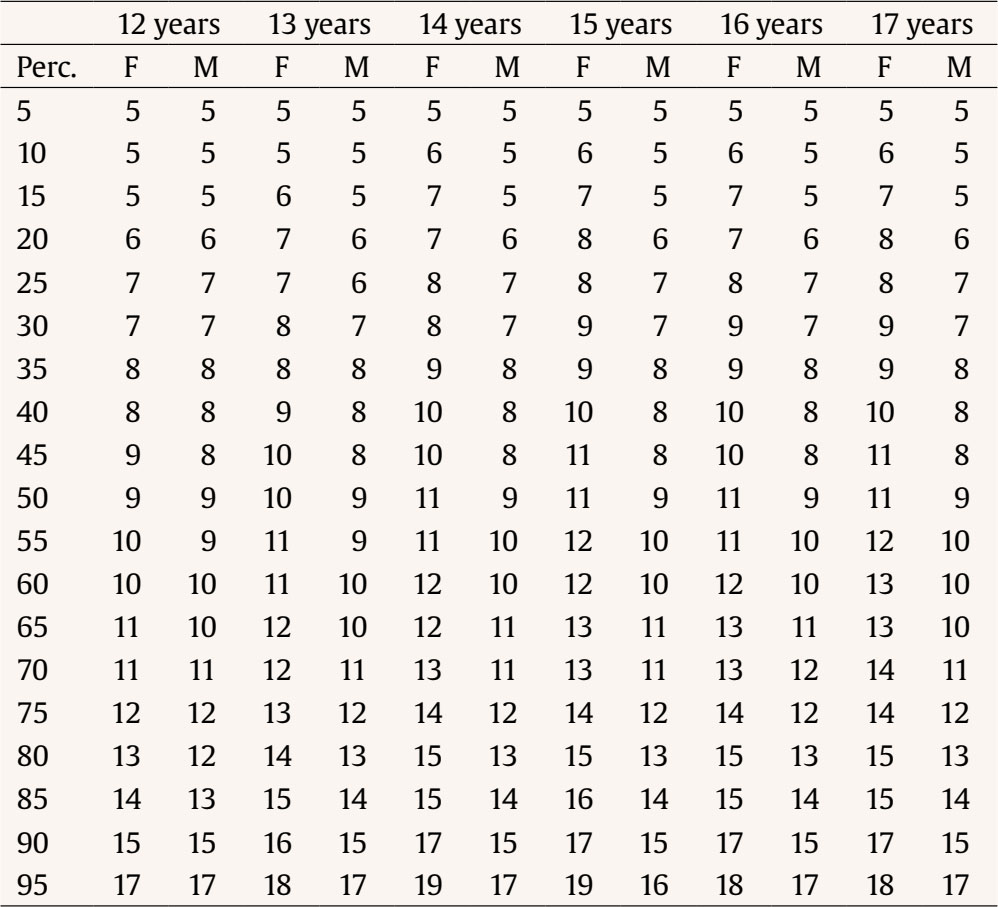 Note. Perc.= percentile; F = female; M = male. Tables 4-5 present the results of the percentiles for each dimension by age and sex of the non-standardized scores, and, on the other hand, the percentiles of the Z scores for these same percentiles studied are presented in Tables 6-7. As can be seen in the previous tables, an increase in self-confidence can be seen both in girls and boys as age increases, although the scores of girls are lower than those of boys at all ages. Researchers have long shown interest in the characteristics of self-esteem in adolescence, as well as its development according to sex and age (Cardenal & Díaz, 2000; Parra et al., 2004; Portillo & Fernández-Baena, 2020; Ramos-Díaz et al., 2017; Tabernero et al., 2017). However, it is necessary to have more information on the differences in self-esteem according to the age and sex of secondary school students. Based on the results of the present study, we can point out that the adaptation carried out by Martín-Albo et al. (2007) of the Rosenberg Self-Esteem Scale (RSES; Rosenberg, 1989) shows a good adjustment to the factorial model, also demonstrating the existence of invariance by sex of the participants. Therefore, it is consistent with the results of Martín-Albo et al. (2007). On the other hand, the analyses carried out make it possible to establish 15 percentiles, both for self-confidence and self-depreciation, by age and sex, thus being possible to establish an updated standardization of the levels of self-esteem expected among Spanish adolescents. Considering the calculation of percentiles, through non-standardized scores and Z scores, the differences by age and sex can be appreciated. Our results show that boys have higher self-esteem than girls, as observed by Cardenal and Díaz (2000), Bleidorn et al. (2016) o Ramos-Díaz et al. (2017) in their research. This, according to Carlo et al. (2014) or Kökönyei et al. (2015), can facilitate a better coping with the changes produced during adolescence. As Parra et al. (2004) indicated, this may be due to the importance given to physique at the beginning of adolescence, mainly by girls, who, in turn, present puberty earlier than boys, as well as the role of women in society, which is transmitted from the educational and social field. On the other hand, as Cardenal and Díaz (2000) pointed out, boys are much more oriented than girls towards academic and intellectual success. The data obtained in this study indicate that there are some higher age differences, and higher gender differences at the beginning of adolescence, most likely as a consequence of the gender in the onset of puberty, especially on a physical level. This is consistent with what was observed by Cardenal and Díaz (2000), who stated that the gender differences could be based on age, with these differences becoming more apparent as age increases, with boys presenting better self-esteem values. Ramos-Díaz et al. (2017) and Parra et al. (2004) also agree on this, which may be related to a higher prevalence of emotional problems in girls during adolescence and behavioral problems in boys (Fonseca-Pedrero et al., 2020). Therefore, in the present study we include the standardization of the test, which allows us to prepare a free and up-to-date, valid, and reliable scale of the expected levels of self-esteem in adolescents in Spain. We believe it will be very useful for different clinical, educational and research professionals, and also as an evaluation instrument for the prevention of emotional and behavioral problems in adolescence, as highlighted by several investigations, such as Ortuño et al. (2014). In this regard, although there are different evaluation instruments, it seems essential to have a short and easy-to-apply instrument, such as the one prepared by Rosenberg (1989) and adapted to Spanish by Martín-Albo et al. (2007). It is a simple and easy-to-apply instrument for clinical and educational professionals and researchers interested in the study of self-esteem, which has been adapted to the Spanish context, just as adaptations were carried out in other countries (Roth et al. 2008; Santos & Maia, 2003; Schmitt & Allik, 2005; Vallieres & Vallerand, 1990). We know there are some limitations in our work, the first being related to the population under study, as, apart from the Spanish population, it would be convenient to collect information from other countries to validate standardization internationally. This would make it possible to prepare a unified scale for the questionnaire and see if the invariance holds on. Another limitation in the sample is the access only to students from public centers. However, it would be interesting to compare with private or subsidized centers. Apart from this, we find the proposal of various researchers (Mateos, 2001; Parra et al., 2004) to carry out a longitudinal study on the structure of the questionnaire very interesting. Although it is true that this is a very ambitious and perhaps complicated project, we believe that it would provide greater rigor to the results already obtained. All in all, thanks to this study, we can offer the educational community an analysis and standardization of the adaptation carried out by Martín-Albo et al. (2007) of the Rosenberg Self-Esteem Scale (RSES; Rosenberg, 1989). Undoubtedly, it is an easy to apply instrument in the classroom, both by teachers and researchers. Conflict of Interest The authors of this article declare no conflict of interest. Acknowledgement We gratefully acknowledge the collaboration of the AI Institutional Intelligence Centre of the Complutense University of Madrid, which provided the data for this study. Cite this article as: Solera, E., Gutiérrez- Gómez-Calcerrada, S., & Calmaestra , J. (2024). Self-esteem levels in a representative sample of Spanish adolescents: Analysis and standardization. Psicología Educativa, 30(1), 39-45. https://doi.org/10.5093/psed2024a3 Funding: This study was financed by Save the Children within the framework of the Bullying, Cyberbullying and Associated Factors project (contract with the Fundación de la Universidad Autónoma de Madrid; Code: 056900) I.P. Juan Calmaestra; and R+D+i, from the Ministry of Industry, Economy and Competitiveness, Spain, under project code PSI2016-74871-R (www.mineco.gob.es) I.P. Eva Romera. Correspondence: sonia.gutierrez@unir.net (S. Gutiérrez Gómez-Calcerrada). References |
Cite this article as: Solera, E., Gutiérrez-Gómez-Calcerrada, S., & Calmaestra, J. (2024). Self-esteem Levels in a Representative Sample of Spanish Adolescents: Analysis and Standardization. PsicologĂa Educativa, 30(1), 39 - 45. https://doi.org/10.5093/psed2024a3
Correspondencia: sonia.gutierrez@unir.net (S. Gutiérrez Gómez-Calcerrada).
Copyright © 2025. Colegio Oficial de la Psicología de Madrid



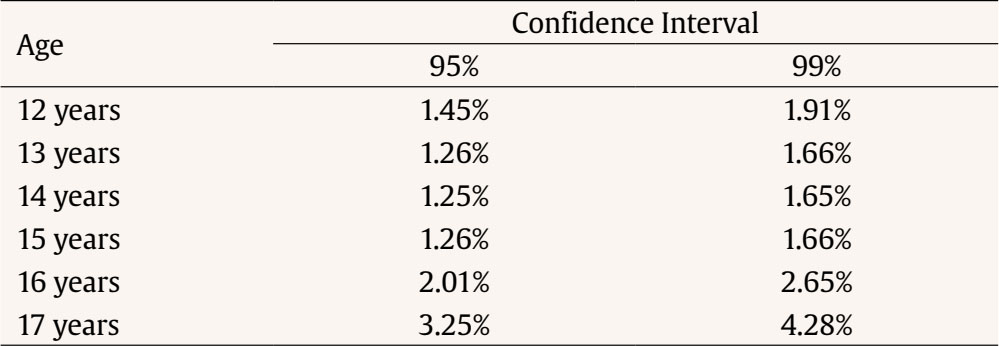

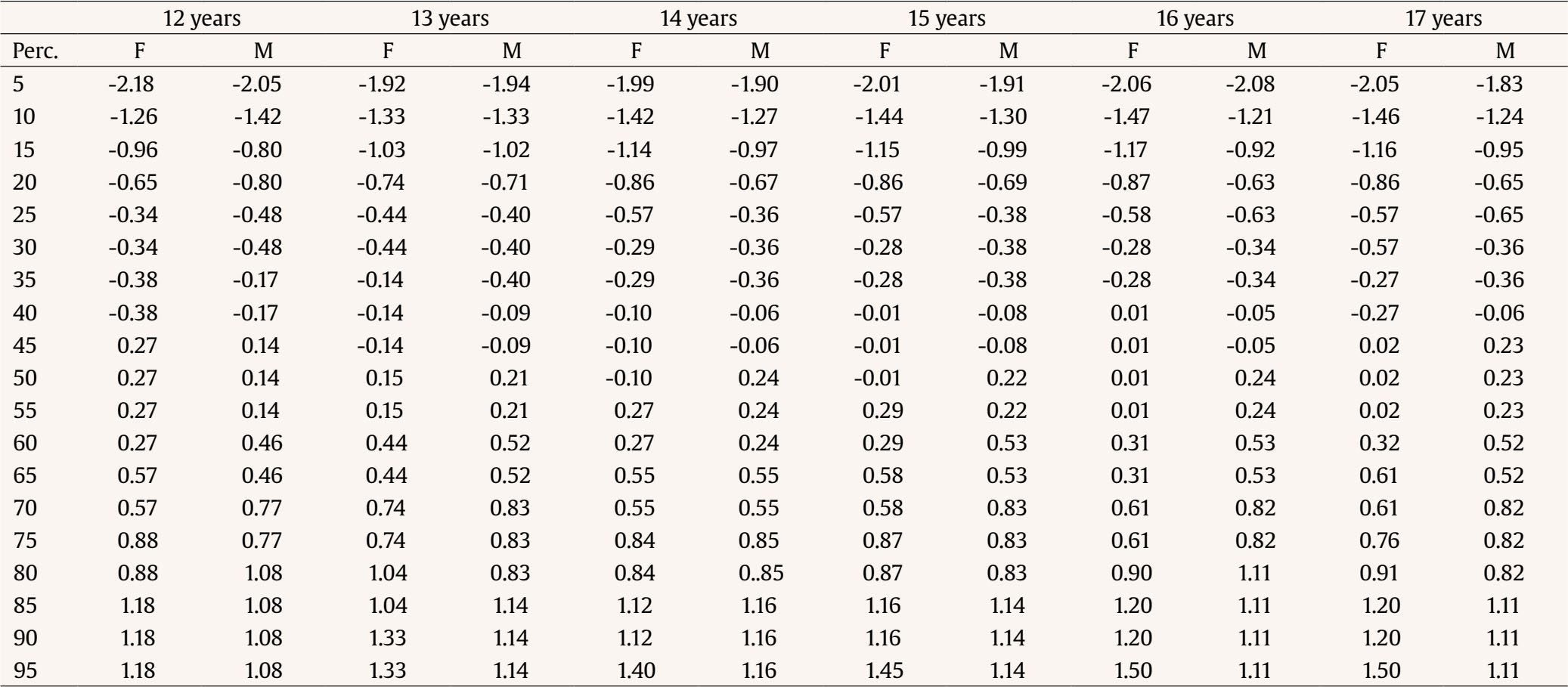
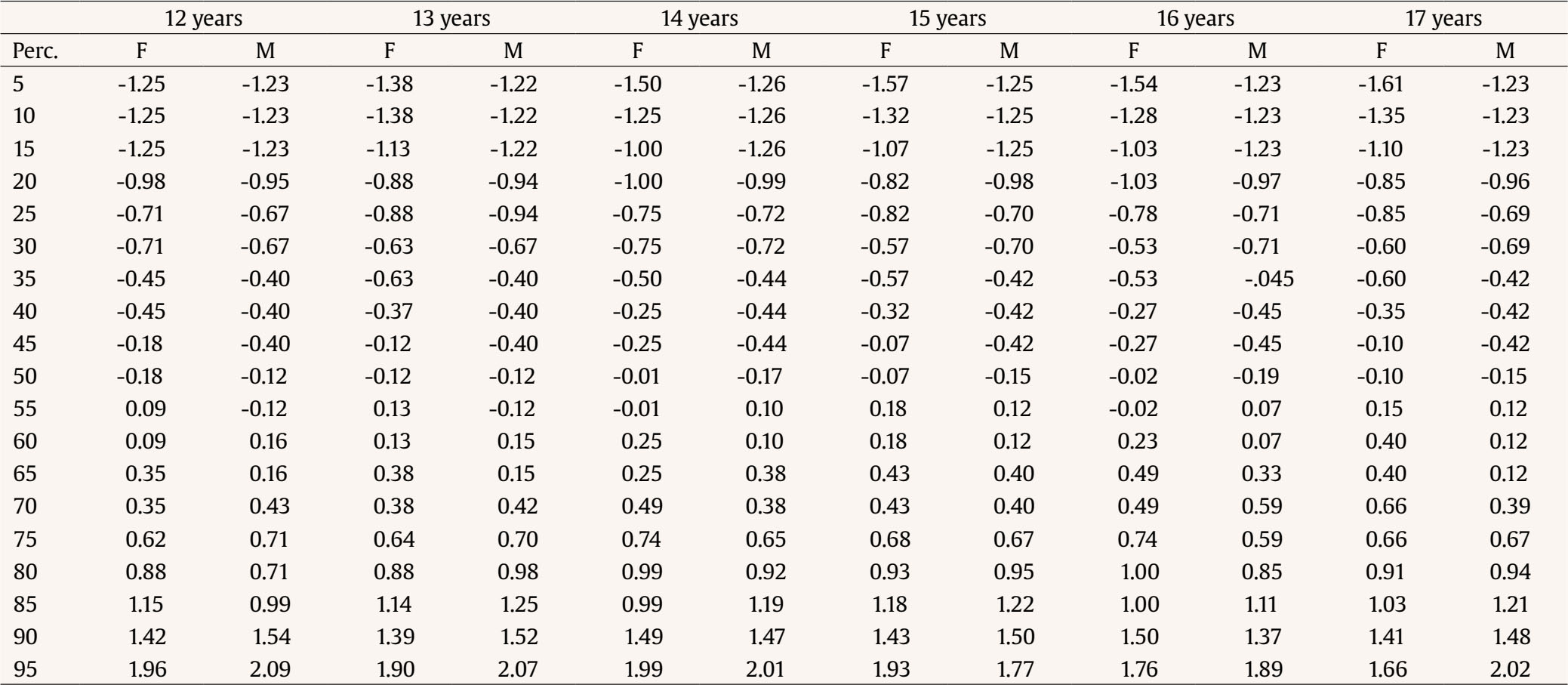






 e-PUB
e-PUB CrossRef
CrossRef JATS
JATS








